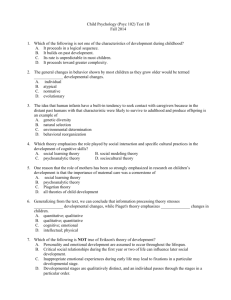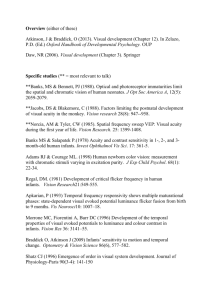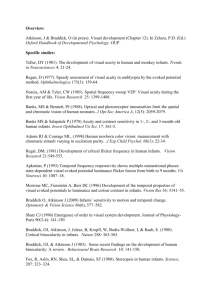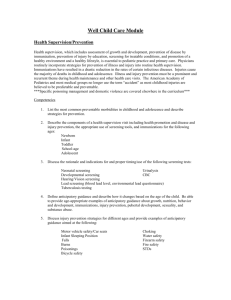TO: The American Academy of Pediatrics 141 Northwest Point
advertisement
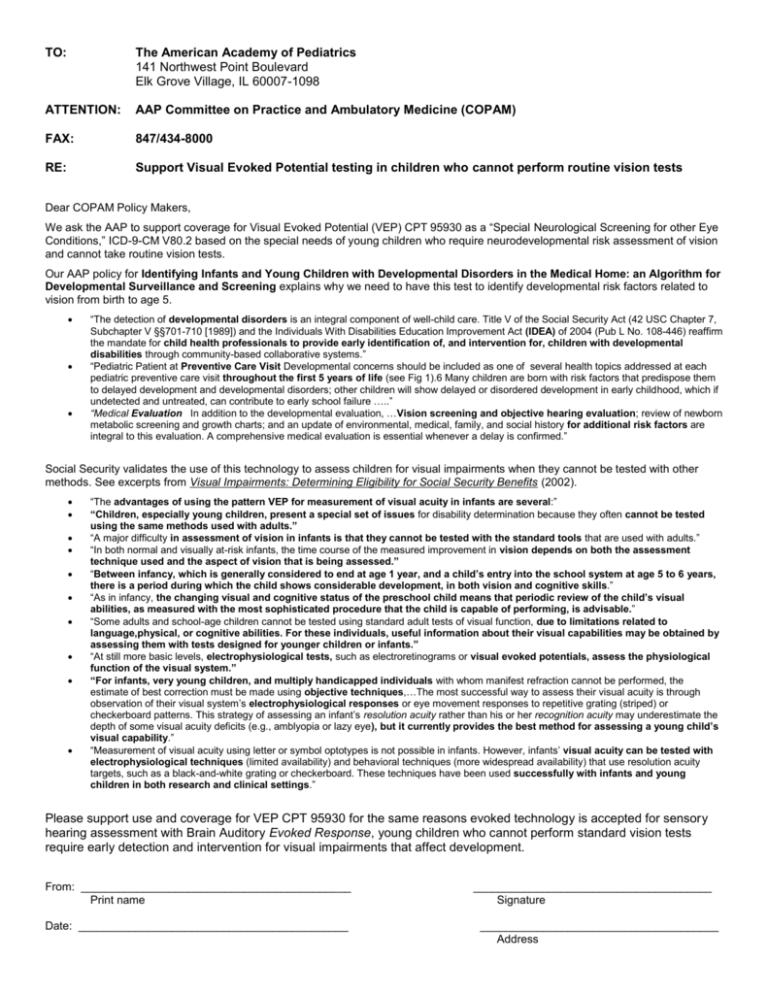
TO: The American Academy of Pediatrics 141 Northwest Point Boulevard Elk Grove Village, IL 60007-1098 ATTENTION: AAP Committee on Practice and Ambulatory Medicine (COPAM) FAX: 847/434-8000 RE: Support Visual Evoked Potential testing in children who cannot perform routine vision tests Dear COPAM Policy Makers, We ask the AAP to support coverage for Visual Evoked Potential (VEP) CPT 95930 as a “Special Neurological Screening for other Eye Conditions,” ICD-9-CM V80.2 based on the special needs of young children who require neurodevelopmental risk assessment of vision and cannot take routine vision tests. Our AAP policy for Identifying Infants and Young Children with Developmental Disorders in the Medical Home: an Algorithm for Developmental Surveillance and Screening explains why we need to have this test to identify developmental risk factors related to vision from birth to age 5. “The detection of developmental disorders is an integral component of well-child care. Title V of the Social Security Act (42 USC Chapter 7, Subchapter V §§701-710 [1989]) and the Individuals With Disabilities Education Improvement Act (IDEA) of 2004 (Pub L No. 108-446) reaffirm the mandate for child health professionals to provide early identification of, and intervention for, children with developmental disabilities through community-based collaborative systems.” “Pediatric Patient at Preventive Care Visit Developmental concerns should be included as one of several health topics addressed at each pediatric preventive care visit throughout the first 5 years of life (see Fig 1).6 Many children are born with risk factors that predispose them to delayed development and developmental disorders; other children will show delayed or disordered development in early childhood, which if undetected and untreated, can contribute to early school failure …..” “Medical Evaluation In addition to the developmental evaluation, …Vision screening and objective hearing evaluation; review of newborn metabolic screening and growth charts; and an update of environmental, medical, family, and social history for additional risk factors are integral to this evaluation. A comprehensive medical evaluation is essential whenever a delay is confirmed.” Social Security validates the use of this technology to assess children for visual impairments when they cannot be tested with other methods. See excerpts from Visual Impairments: Determining Eligibility for Social Security Benefits (2002). “The advantages of using the pattern VEP for measurement of visual acuity in infants are several:” “Children, especially young children, present a special set of issues for disability determination because they often cannot be tested using the same methods used with adults.” “A major difficulty in assessment of vision in infants is that they cannot be tested with the standard tools that are used with adults.” “In both normal and visually at-risk infants, the time course of the measured improvement in vision depends on both the assessment technique used and the aspect of vision that is being assessed.” “Between infancy, which is generally considered to end at age 1 year, and a child’s entry into the school system at age 5 to 6 years, there is a period during which the child shows considerable development, in both vision and cognitive skills.” “As in infancy, the changing visual and cognitive status of the preschool child means that periodic review of the child’s visual abilities, as measured with the most sophisticated procedure that the child is capable of performing, is advisable.” “Some adults and school-age children cannot be tested using standard adult tests of visual function, due to limitations related to language,physical, or cognitive abilities. For these individuals, useful information about their visual capabilities may be obtained by assessing them with tests designed for younger children or infants.” “At still more basic levels, electrophysiological tests, such as electroretinograms or visual evoked potentials, assess the physiological function of the visual system.” “For infants, very young children, and multiply handicapped individuals with whom manifest refraction cannot be performed, the estimate of best correction must be made using objective techniques,…The most successful way to assess their visual acuity is through observation of their visual system’s electrophysiological responses or eye movement responses to repetitive grating (striped) or checkerboard patterns. This strategy of assessing an infant’s resolution acuity rather than his or her recognition acuity may underestimate the depth of some visual acuity deficits (e.g., amblyopia or lazy eye), but it currently provides the best method for assessing a young child’s visual capability.” “Measurement of visual acuity using letter or symbol optotypes is not possible in infants. However, infants’ visual acuity can be tested with electrophysiological techniques (limited availability) and behavioral techniques (more widespread availability) that use resolution acuity targets, such as a black-and-white grating or checkerboard. These techniques have been used successfully with infants and young children in both research and clinical settings.” Please support use and coverage for VEP CPT 95930 for the same reasons evoked technology is accepted for sensory hearing assessment with Brain Auditory Evoked Response, young children who cannot perform standard vision tests require early detection and intervention for visual impairments that affect development. From: ___________________________________________ Print name Date: ___________________________________________ ______________________________________ Signature ______________________________________ Address

